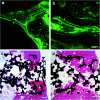Sintered porous Ti6Al4V scaffolds incorporated with recombinant human bone morphogenetic protein-2 microspheres and thermosensitive hydrogels can enhance bone regeneration
- PMID: 35518032
- PMCID: PMC9059563
- DOI: 10.1039/c8ra10200g
Sintered porous Ti6Al4V scaffolds incorporated with recombinant human bone morphogenetic protein-2 microspheres and thermosensitive hydrogels can enhance bone regeneration
Abstract
A well-controlled powder sintering technique was used to fabricate porous Ti6Al4V scaffold. The thermosensitive chitosan thioglycolic acid (CS-TA) hydrogel was used as a carrier to inject recombinant human bone morphogenetic protein-2 (rhBMP-2) microspheres into pores of the Ti6Al4V scaffold at 37 °C, and then the porous Ti6Al4V/rhBMP-2 loaded hydrogel composite was obtained. The bare Ti6Al4V scaffold was used as the control. The characteristics and mechanical properties of the scaffold, rheological properties of the hydrogels and the rhBMP-2 loaded hydrogel, the release of the rhBMP-2 loaded hydrogel, and the biological properties of the two types of samples were evaluated by in vitro and in vivo tests. Results indicated that the sintered porous Ti6Al4V had high porosity, large pore size with good mechanical properties. The hydrogel and rhBMP-2 loaded hydrogel showed thermosensity. The rhBMP-2 loaded hydrogel showed a stable and extended release profile without too high burst release of rhBMP-2. Both groups showed good biocompatibility and osteogenic ability. However, according to the results of cell tests and implantation, the group with rhBMP-2 loaded hydrogel had significantly higher cell proliferation rate, faster bone growth speed, and more bone ingrowth at every time point. Therefore, the sintered porous Ti6Al4V scaffolds incorporated with rhBMP-2 microspheres and CS-TA hydrogel was effective in enhancing the bone regeneration, and prospects a good candidate for application in orthopedics.
This journal is © The Royal Society of Chemistry.
Conflict of interest statement
There are no conflicts to declare.
Figures







Similar articles
-
Enhanced regeneration of bone defects using sintered porous Ti6Al4V scaffolds incorporated with mesenchymal stem cells and platelet-rich plasma.RSC Adv. 2021 Jan 26;11(9):5128-5138. doi: 10.1039/d0ra10215f. eCollection 2021 Jan 25. RSC Adv. 2021. PMID: 35424426 Free PMC article.
-
In vitro sustained release of recombinant human bone morphogenetic protein-2 microspheres embedded in thermosensitive hydrogels.Pharmazie. 2012 Apr;67(4):299-303. Pharmazie. 2012. PMID: 22570935
-
Bone regeneration using photocrosslinked hydrogel incorporating rhBMP-2 loaded 2-N, 6-O-sulfated chitosan nanoparticles.Biomaterials. 2014 Mar;35(9):2730-42. doi: 10.1016/j.biomaterials.2013.12.028. Epub 2014 Jan 15. Biomaterials. 2014. PMID: 24438908
-
Controlled-release of bone morphogenetic protein-2 from a microsphere coating applied to acid-etched Ti6AL4V implants increases biological bone growth in vivo.J Orthop Res. 2014 Jun;32(6):744-51. doi: 10.1002/jor.22594. Epub 2014 Feb 17. J Orthop Res. 2014. PMID: 24536004
-
In vitro and in vivo comparisons of the porous Ti6Al4V alloys fabricated by the selective laser melting technique and a new sintering technique.J Mech Behav Biomed Mater. 2019 Mar;91:149-158. doi: 10.1016/j.jmbbm.2018.12.007. Epub 2018 Dec 10. J Mech Behav Biomed Mater. 2019. PMID: 30579112
Cited by
-
Enhanced regeneration of bone defects using sintered porous Ti6Al4V scaffolds incorporated with mesenchymal stem cells and platelet-rich plasma.RSC Adv. 2021 Jan 26;11(9):5128-5138. doi: 10.1039/d0ra10215f. eCollection 2021 Jan 25. RSC Adv. 2021. PMID: 35424426 Free PMC article.
-
Smart Hydrogels for Advanced Drug Delivery Systems.Int J Mol Sci. 2022 Mar 27;23(7):3665. doi: 10.3390/ijms23073665. Int J Mol Sci. 2022. PMID: 35409025 Free PMC article. Review.
-
Applications of Stimuli-Responsive Hydrogels in Bone and Cartilage Regeneration.Pharmaceutics. 2023 Mar 18;15(3):982. doi: 10.3390/pharmaceutics15030982. Pharmaceutics. 2023. PMID: 36986842 Free PMC article. Review.
-
Recent advances of chitosan-based composite hydrogel materials in application of bone tissue engineering.Heliyon. 2024 Sep 7;10(19):e37431. doi: 10.1016/j.heliyon.2024.e37431. eCollection 2024 Oct 15. Heliyon. 2024. PMID: 39381099 Free PMC article. Review.
References
-
- Ilan D. I. and Ladd A. L., Operative Techniques in Plastic & Reconstructive Surgery, 2012, vol. 28, pp. 457–468
LinkOut - more resources
Full Text Sources
Research Materials

